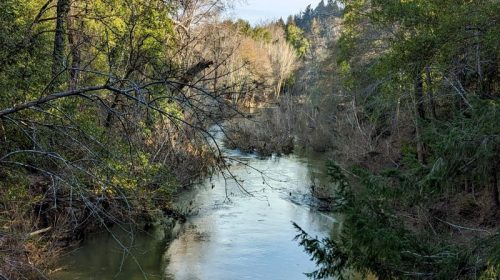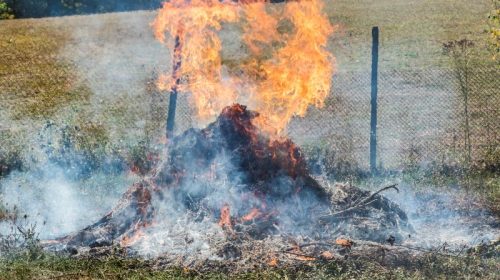Birdwatching: A Feathered Adventure in the Santa Cruz Mountains
By Mary Andersen
Looking for an outdoor hobby? Birdwatching in the San Lorenzo Valley is at its best during the spring and fall migration seasons, when diverse arrays of species pass through or settle in the area. Now through May is prime viewing time as migratory birds return on their way north. April saw the arrival of songbirds like warblers, vireos, and flycatchers, while May is excellent for spotting colorful species such as Western Tanagers and Black-headed Grosbeaks. SLV offers an idyllic escape for birdwatchers. Our mountain communities boast a rich variety of habitats – redwood forests, oak woodlands, and riparian corridors along the San Lorenzo River – that attract diverse species. Mild weather and blooming environments also make it ideal for both birds and birdwatchers.
In a recent Sempervirens column, international expert birding guide Alvaro Jaramillo said, “The first thing is to just pay attention when you are outside, intentionally look and listen. Paying attention to birds will bring a new perspective to your outdoor hikes and walks. Birding not only fills you with the sights and sounds of these amazing and common inhabitants of the forest, but it will make you focus at times in a deeply contemplative and wonderful way.”
Pileated Woodpeckers (Photo by Stephanie Starr)
According to Visit Santa Cruz, over 400 migratory and permanent bird species can be found throughout the county. SLV’s variety is impressive. In the redwoods, you might spot the Pileated Woodpecker, a striking bird with a flaming red crest, hammering away at tree trunks in search of ants – its primary food source. Along the creeks and riverbanks, the American Dipper stands out with its quirky habit of bobbing up and down before diving underwater to forage for insects, unfazed by currents. Overhead, keen-eyed watchers may catch sight of Bald Eagles or Ospreys soaring above Loch Lomond Reservoir, hunting fish with incredible precision. Hummingbirds, like the resident Anna’s with its iridescent magenta throat, dart among wildflowers, their rapid wing beats a blur of energy.


Song Sparrow (left) sings a sweet melody of multiple phrases that starts with well-spaced notes and finishes with a trill. House Finch (right) gets its name due to its penchant for nesting near suburban and rural structures. (Photos by Gerry Woodling)
The Common Merganser, often seen on the river, dives with synchronized grace to catch small fish, while the California Quail scurries in family groups through underbrush, their comical topknots bobbing as they forage for seeds. Spring reveals nesting season, with Yellow Warblers weaving intricate homes in riverside shrubs, their cheerful songs filling the air.
For the best viewing, head to Henry Cowell Redwoods State Park in Felton, where trails wind through redwood groves and along the river, offering prime spots for spotting thrushes, woodpeckers, and dippers. Loch Lomond Reservoir, surrounded by mixed evergreen forest, is perfect for watching raptors and waterfowl. Felton Covered Bridge Park provides easy access to the river’s edge, ideal for glimpsing mergansers and warblers. Highlands County Park near Ben Lomond offers broad river frontage and a mix of habitats, ensuring sightings. At Big Basin, spot the aforementioned Pileated Woodpecker. The park’s slower pace means less people and a better opportunity to view.

Chestnut Backed Chickadees are social birds that hop and glean food from branches, often hanging upside down to reach food under branches and needles. (Photo by Vijay Nidugondi)
Chestnut-backed Chickadees are year-round residents in the Santa Cruz Mountains. Unlike migratory birds, these chickadees stick around thanks to the region’s mild climate and abundant food sources. They thrive in coniferous forests, particularly among redwoods, Douglas firs, and mixed evergreen woodlands that dominate the region. Since they’re not tied to migration, your best bet for seeing chickadees is to visit shaded, moist forest areas like Henry Cowell. Listen for their high-pitched chatter and watch for their rusty-brown backs and white faces with black caps. Early mornings are ideal, as they’re most active then, searching for insects under bark or in needle clusters. Bring binoculars – they’re tiny and quick!
Provisions
Starting out doesn’t require much gear. A pair of entry-level binoculars, like the Nikon Prostaff 8×42, offers crisp views without breaking the bank. Look for lightweight models with good magnification (8x or 10x) and a wide field of view. A simple field guide, such as The Sibley Field Guide to Birds of Western North America, helps identify species with detailed illustrations and habitat notes. Visit Santa Cruz publishes a free 56-page Wildlife Watching Guide with information on the best times of the year to view birds. The latest edition features San Vicente Redwoods for the first time. Download the free Merlin app from Cornell Lab for on-the-spot identification using photos or sounds. Comfortable shoes, a notebook, and patience round out the kit – birds reward those who linger quietly.
Birdwatching Clubs
In the Santa Cruz Mountains several active groups cater to enthusiasts.
The Santa Cruz Bird Club is the primary birdwatching group in the region, deeply rooted in Santa Cruz County since its founding in 1956. It’s highly active in the San Lorenzo Valley and Santa Cruz Mountains, organizing near-weekly field trips to Henry Cowell, Loch Lomond, Quail Hollow Ranch, and other mountain sites. The club also hosts meetings with talks on birds, plus public events like summer picnics. It’s a welcoming group for all levels, and their online guides – such as the Birding Guide to Santa Cruz County – highlight specific mountain locations. Visit santacruzbirdclub.org for schedules and membership, which is open to anyone.
Santa Clara Valley Bird Alliance is based in Santa Clara County, however this group (formerly Santa Clara Valley Audubon Society) frequently ventures into the Santa Cruz Mountains, including areas overlapping with the San Lorenzo Valley like Castle Rock State Park. Their field trips, listed on scvbirdalliance.org, often focus on mountain migration spots where you might catch warblers and hummingbirds in spring. They’re active year-round, with a strong emphasis on conservation and education.
The Monterey Audubon Society covers parts of Santa Cruz County, including the southern Santa Cruz Mountains, though its focus leans toward Monterey Bay. They occasionally lead trips into the mountains near Felton or Ben Lomond, especially for forest birds like the Pileated Woodpecker. As an all-volunteer organization, their outings are less frequent in SLV but worth watching for on montereyaudubon.org, particularly if you’re open to coastal trips that complement mountain birding.
Featured Photo: White Crowned Sparrow
The White Crowned Sparrow shown at the top of the page was taken by photographer Gerry Woodling. Gerry loves birds. The self-proclaimed photographer at large and visual storyteller writes, “I always loved taking pictures as a kid but did not get bitten by the photography bug until I was fifty.” Gerry is also drummer with the Lloyd Whitley Blues Band. View and purchase his photography: gerrywoodlingphotography.com
***
Have photos or a local story to share? The team at the San Lorenzo Valley Post welcomes your Santa Cruz Mountains news, story ideas, photos, and letters. Send us an email.
Sign up for our newsletter to stay connected to news and events in the Santa Cruz Mountains.
The San Lorenzo Valley Post is your essential guide to life in the Santa Cruz Mountains. We're dedicated to delivering the latest news, events, and stories that matter to our community. From local government to schools, from environmental issues to the arts, we're committed to providing comprehensive and unbiased coverage. We believe in the power of community journalism and strive to be a platform for diverse voices.





